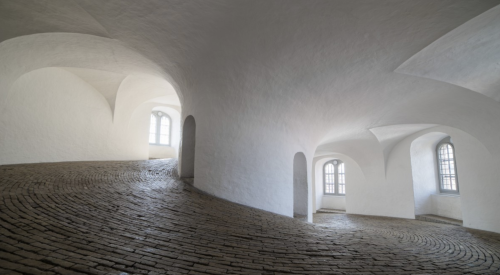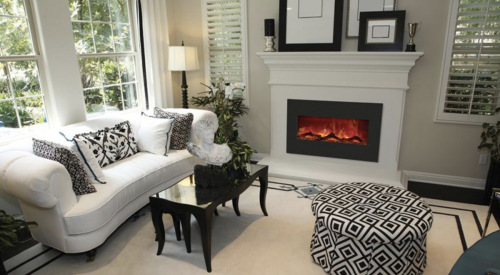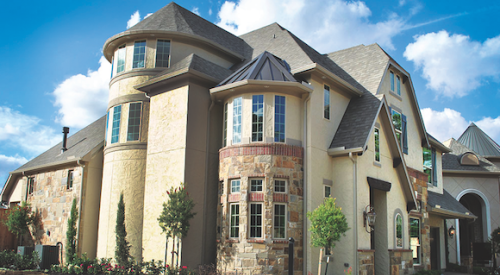| As part of Louisiana-Pacific's Engineered for Life TM program, ducts in conditioned space should be fully enclosed and insulated to an R-4 minimum and mastic must be used for all duct openings.
|
Do the coming years portend an energy crisis for the United States? If so, what can builders do to help offset it?
According to an early release of the Annual Energy Outlook 2001 by the Department of EnergyÆs Information Administration, the average wellhead price of natural gas is projected to increase from $2.08 per 1000 cubic feet in 1999 to $3.13 per 1000 cubic feet in 2020. What this can mean to consumersÆ pocketbooks can only be guessed at. But one thing seems certain. Energy costs will rise. Therefore it may be to buildersÆ advantage to make sure that the homes they build use energy as efficiently as possible.
Some may point out that this is already taking place. HVAC equipment is smaller and better, and building envelopes are tighter, for instance. But while there has been progress in equipment technologies and building materials, efficiency experts like Advanced EnergyÆs Keith Aldridge, believe there is still room for improvement. Simply put, itÆs not innovations we need, we just needed to build homes better.
He says the key to making any new home more energy efficient is to first look at the house as a system and recognize that what you do in one area can, and probably will, affect another area. This means, says Aldridge, that if we want durable housing that is safe, comfortable and affordable, we must understand how air flow, both uncontrolled (infiltration) and controlled (ventilation), affects a house; how moisture migrates through the living space and assemblies of a house; how heat loss and gain can be managed productively; and how the environment (both indoors and outdoors) is affected by construction techniques.
"We look at how each change in construction techniques or materials will affect four different areas: health of the occupants and building, durability of the structure, comfort of the indoor environment, and efficient operation and maintenance."
Building Sales
Whether it be for more sales, fewer callbacks or simply because itÆs the right thing to do in a world thatÆs become increasingly concerned with environmental issues, builders are looking to increase the energy efficiency of the new homes they build.
Chicago-area builder Perry BigelowùwhoÆs been building energy efficient housing for over 20 yearsùsays it gives him tremendous credibility in the marketplace. He does this by guaranteeing that the annual heating costs in his new homes will not exceed $400 a year for a three-year period. If they do, he will cut a check to the homeowner for the difference. And it worksùin 15 years, Bigelow has only paid out about $475 to homeowners (although this year he expects heÆll be making at least a few payments as skyrocketing gas prices drive up utility bills).
Because of the program, buyers perceive him as a quality builder. "You canÆt build a lousy house and [at the same time] guarantee the heating costs, and the client understands that." Bigelow says.
The core of his program is to increase the amounts of insulation by roughly 50 percent over what most builders use. He makes the house very tight and then uses continuous mechanical ventilation to provide fresh air all the time. And then he puts the gas appliancesùfurnace and water heaterùoutside the air envelope of the house.
"Houses always have a number of mechanical devices like exhaust fans and drier vents creating negative air pressure inside" Bigelow explains. "If you put gas appliances inside this air envelope, the air supply they need comes down the chimney. So, when the furnace is turned on, the products of combustion canÆt go up the chimney because thereÆs already a downdraft and the combustion products spill out into the house. This causes major problems."
Other construction details Bigelow Homes implements include advanced engineered framing methods, a 1" polyisocyanurate exterior sheathing, double-glazed low-e vinyl windows, raised heel trusses for adequate clearance for R-30 insulation and a 1" thermal break to prevent cold from migrating across the floor from the exterior concrete to the interior concrete.
Building Customer Satisfaction
As a recent winner of a J.D. Power and Associates Home Builder Industry Award 2000, Randy Folts is a big fan of the systems approach to achieving both energy efficiency and customer satisfaction.
Folts, Group Vice President of Construction for Pulte West, builds homes in the tri-state area of Arizona, California and Nevada. He says that the J.D. Power Award dovetailed with ongoing internal customer service surveys, with much of the success in both surveys attributable to PulteÆs systems approach and energy efficiency measures.
Folts says PulteÆs success comes from partnering with the Building Science Corporation and Louisiana-PacificÆs Engineered For LifeTM programùa three-tiered set of standards that, when followed, are able to project a buildingÆs performance.
"WeÆve learned a lot in the past couple of years. We used to think energy efficiency was just a plain old R-value. We never talked about efficiencies of installation and knowing that you could take an R-30 batt, stuff it in a cavity in a ceiling plane, and maybe get only 50 percent performance out of that batt."
Folts says that there are a number of different things heÆs looking at to offset these problems including advanced framing techniques. He says this should yield a better thermal envelope with less wood so that it allows more space to insulate. And the bottom line should be a better job for fewer dollars.
And letÆs face it,a better job for less money is what all builders are looking for. Imagine getting energy efficiency to boot.
Sidebar:











